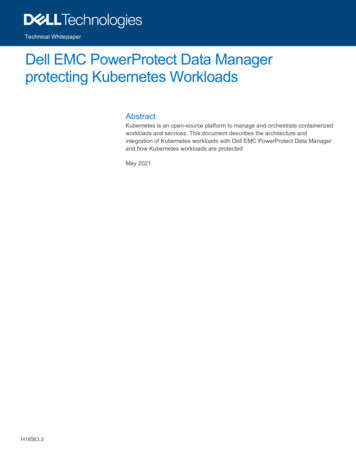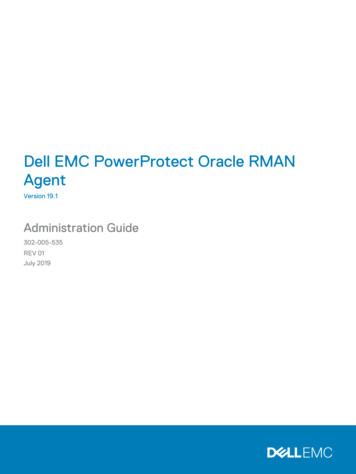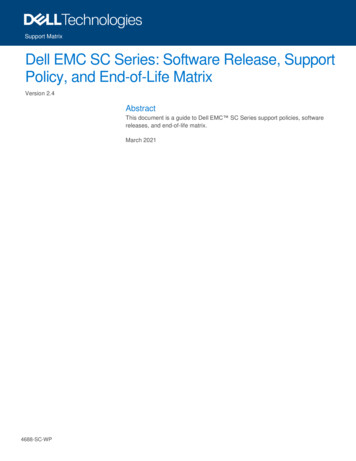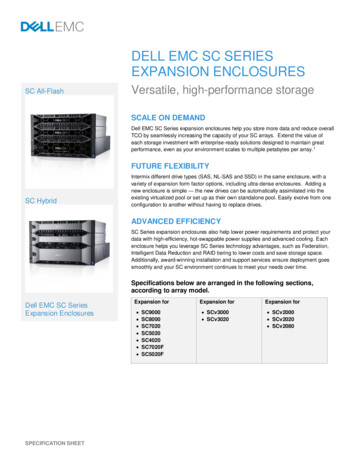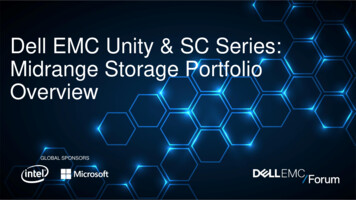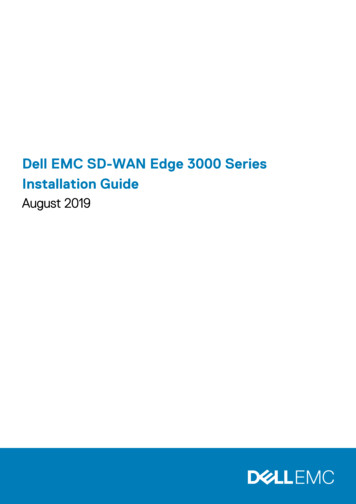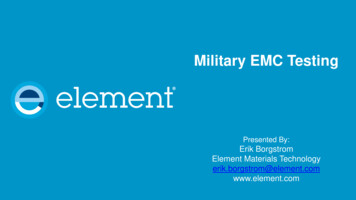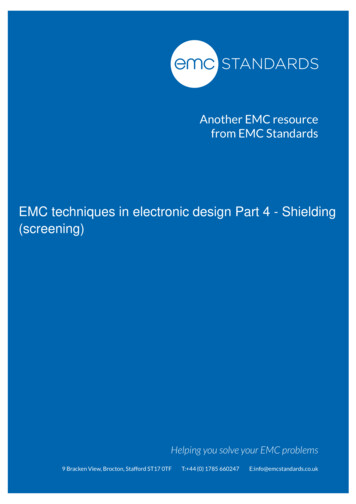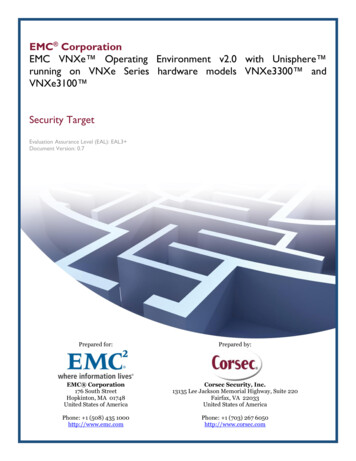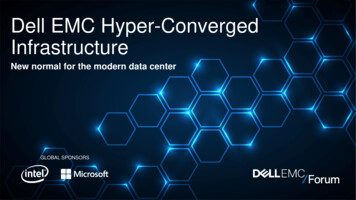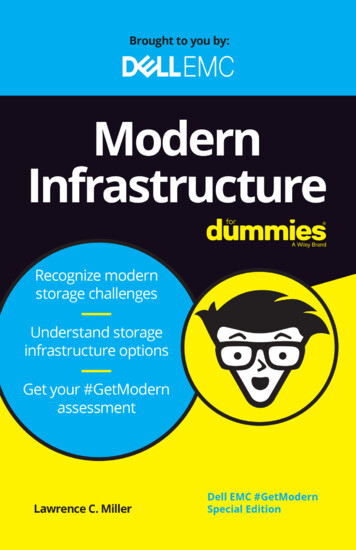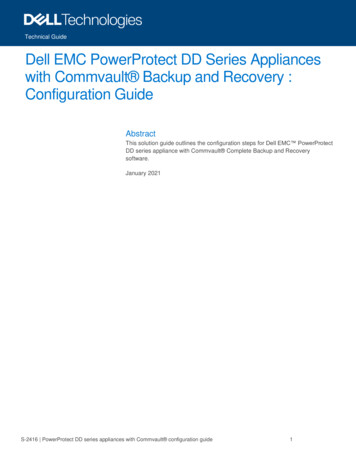
Transcription
Technical GuideDell EMC PowerProtect DD Series Applianceswith Commvault Backup and Recovery :Configuration GuideAbstractThis solution guide outlines the configuration steps for Dell EMC PowerProtectDD series appliance with Commvault Complete Backup and Recoverysoftware.January 2021S-2416 PowerProtect DD series appliances with Commvault configuration guide1
RevisionsDateDescriptionJanuary 2021Initial releaseAcknowledgmentsAuthor: Sonali DwivediThe information in this publication is provided “as is.” Dell Inc. makes no representations or warranties of any kind with respect to the information in thispublication, and specifically disclaims implied warranties of merchantability or fitness for a particular purpose.Use, copying, and distribution of any software described in this publication requires an applicable software license.Copyright Dell Inc. or its subsidiaries. All Rights Reserved. Dell Technologies, Dell, EMC, Dell EMC and other trademarks are trademarks of Dell Inc.or its subsidiaries. Other trademarks may be trademarks of their respective owners. [1/4/2021] [Technical Guide] [S-2416 PowerProtect DD seriesappliances with Commvault configuration guide]S-2416 PowerProtect DD series appliances with Commvault configuration guide2
Table of contentsRevisions.2Acknowledgments .2Table of contents .3Executive summary .51Solution Components .51.1PowerProtect DD series appliances .51.2Commvault Complete Data Protection .72Reference Architecture .83Configuration Overview .93.1Configuring CIFS on DD series appliances and Commvault .103.1.1 Enabling Basic CIFS Access on DD Series .103.1.2 Creating CIFS Device in Commvault .123.2Configuring NFS on DD series appliances and Commvault .153.2.1 Enabling Basic NFS Access on DD Series Appliances .153.2.2 Creating NFS Device in Commvault .173.3Configuring DD BoostFS plug-in in Commvault .193.3.1 Preparing DD series appliances for DD BoostFS .203.3.2 DD BoostFS plug-in settings for Windows Client in Commvault .223.3.3 DD BoostFS plug-in settings for Linux Client in Commvault .243.4Configuring DD VTL and adding it to Commvault .263.4.1 Configure and setup DD series appliances as VTL target .263.4.2 Configure the new VTL on the Commvault MediaAgent server. .294Backups .304.1Performing a Windows or Linux Server Backup .304.2Performing NAS Client Backup .365Restores .376PowerProtect DD Replication and Restore from Replication .3976.1CIFS restore .416.2NFS restore .416.3DD BoostFS restore .41Dell EMC Cloud Tier .427.1Enable Cloud Tier on DD series appliances .437.2Cloud Configuration on DD series appliances .487.3Moving files from Active Tier to Cloud Tier .48S-2416 PowerProtect DD series appliances with Commvault configuration guide3
ATechnical support and resources .54A.1Related resources.54S-2416 PowerProtect DD series appliances with Commvault configuration guide4
Executive summaryWith improvements in disk technology and cost, disk-to-disk backup has become a preferred solution forprotecting data, a valuable corporate asset. However, there is a world of difference between writing backupsto disk and designing a disk-based data protection solution optimized for fast and reliable recoveries.Dell Technologies is the industry’s leading provider Purpose Built Backup Appliances (PBBA). PowerProtectDD series appliances are uniquely designed for cost-efficient, fast, and verifiable data protection. DD seriesdeduplication technology provides up to 65:1 data reduction. DD series enables network-efficient WAN andFC vaulting for disaster recovery (DR), remote office data protection and tape consolidation.In addition, DD series offers unprecedented levels of data integrity, verification and self-healing, which areunavailable in traditional file systems or conventional disk systems. DD series support a wide array of thirdparty backup applications, including Commvault. DD series offers remarkable improvements in performance,reliability, and TCO to any IT organization considering disk-based solutions for both onsite and offsite dataprotection.This guide will go over configuring various protocols of DD series appliances with Commvault backupsoftware.1Solution ComponentsThe solution components described in this document include Commvault Complete Backup and Recovery11 and Dell EMC PowerProtect DD series appliance.1.1PowerProtect DD series appliancesDD series appliances and older Data Domain systems are disk-based appliances that run DD OS to provideinline deduplication for data protection and disaster recovery (DR) in the enterprise environment and servesas a target appliance for backup applications.DD series provides high-speed backup and restores with scalable deduplication. DD series incorporates aData Invulnerability Architecture, which delivers the highest levels of data integrity and recoverability by endto-end verification, fault tolerance and containment and continuous fault detection and healing. Its seamlessintegration with existing infrastructures, enabling ease-of-use with leading backup and archiving applications,and offering superior performance with Dell EMC PowerProtect Software and Dell EMC Data Protection Suite.DD Series appliances can be deployed physically or virtually. The virtual appliance is known as PowerProtectDD Virtual Edition (DDVE) and has some different limitations from the physical appliance, such as maximumcapacity. DD series supports multiple front-end protocols such as CIFS/NFS, DD VTL and its own DD Boostprotocol. DD series can integrate with and supported by many popular backup software offerings. DD seriesuses disk storage with deduplication. Deduplication technology and, Global Compression, reduces data downto its raw essentials by pooling redundant patterns within a file, across files, and even within a block, andstores only unique data segments. This compression algorithm aggressively minimizes the capacity neededfor storing backup images.The primary storage for DD series is called the active tier. DD Series also supports a secondary tier calledcloud tier. The cloud tier is a separate deduplication domain from the active tier. There is a cache disk that isset up for the cloud tier that is separate than the disk storage used for the active tier. The data is either movedS-2416 PowerProtect DD series appliances with Commvault configuration guide5
from the active tier to the cloud tier-based on age of data or by an application policy from a supported backupapplication.DD OS features include: Data integrity—The DD OS Data Invulnerability Architecture protects against data loss fromhardware and software failures.Data Deduplication—The file system deduplicates data by identifying redundant data during eachbackup and storing unique data once.Restore operations—File restore operations create little or no contention with backup or otherrestore operations.DD Replicator—DD Replicator sets up and manages the replication of backup data between twoprotection systems.Multipath and load balancing—In a Fibre Channel multipath configuration, multiple paths areestablished between a protection system and a backup server or backup destination array. Whenmultiple paths are present, the system automatically balances the backup load between the availablepaths.High availability—The High Availability (HA) feature lets you configure two protection systems as anActive-Standby pair, providing redundancy in the event of a system failure. HA keeps the active andstandby systems synchronized, so that if the active node were to fail due to hardware or softwareissues, the standby node can take over services and continue where the failing node left off.Random I/O handling—The random I/O optimizations in DD OS provide improved performance forapplications and use cases that generate larger amounts of random read and write operations thansequential read and write operations.S-2416 PowerProtect DD series appliances with Commvault configuration guide6
1.2System Administrator access—System administrators can access the system for configuration andmanagement using a command-line interface (CLI) or a UI (user interface).Licensed features—Feature licenses allow you to purchase only those features you intend to use.Some examples of features that require licenses are DD Boost, and capacity on demand (storagecapacity increases).Storage environment integration—DD OS systems integrate easily into existing data centersCommvault Complete Data ProtectionCommvault Complete Data Protection previously known as Simpana is an enterprise level, integrated dataand information management solution, built on a single platform and unified code base. The Commvaultarchitecture first requires discussing the various components and their functions. The iDataAgent software isdeployed on all servers, workstations, and laptops where backups are needed.The MediaAgent software is deployed on dedicated servers, maintains the deduplication databases, andmanages the transfer of data between the clients and DD Series. Multiple MediaAgent are used to distributethe load. DD Series is set up as a storage target using CIFS/NFS, DD Boost, DDVTL and is a backup target.Depending on the size of the environment, or the network and physical boundaries, there can be multipleCommCell within an organization and multiple DD Series can be added as backup target.Some of the main components of Commvault backup solution are as follows: CommCell ConsoleThe CommCell Console is the central management user interface for managing the CommCell group—monitoring and controlling active jobs, and viewing events related to all activities. The CommCell Consoleallows centralized and decentralized organizations to manage all data-movement activities through a single,common interface. CommServeThe CommServe host is the central management component of the CommCell group. It coordinates andperforms all CommCell group operations, maintaining Microsoft SQL Server databases that contain allconfiguration, security, and operational history for the CommCell group. There can be only one CommServehost in a CommCell group. The CommServe software can be installed in physical, virtual, and clusteredS-2416 PowerProtect DD series appliances with Commvault configuration guide7
environments but only on a Microsoft Windows host. Commvault supports high availability by replicatingdata to a standby CommServe host. MediaAgentThe MediaAgent is the data-transmission manager in the CommCell group. It provides high-performance datamovement and manages the storage libraries. The CommServe server coordinates MediaAgent tasks. TheMediaAgent software can be installed in physical, virtual, and clustered environments. A MediaAgent can beinstalled on a Windows or UNIX host. ClientA client is a logical grouping of the software agents that facilitate the protection, management, and movementof data associated with the client. iDataAgentAn agent is a software module that is installed on a client computer to protect a specific type of data. Differentagent software is available to manage different datatype on a client, such as Windows file-system data orOracle databases. Agent software can be installed in physical, virtual, and clustered environments, and maybe installed either on the computer or on a proxy server. Storage PolicyStorage policies act as a channel for backup and restore operations. They map data from its original locationto physical media. A policy can be used for either data protection and archiving or disaster recovery.Retention and reduplication properties can also be defined here. SubclientSubclients are logical containers that define the specific production data (virtual machines, drives, folders,files, databases, mailboxes) to be protected on a client.2Reference ArchitectureDD Series is presented to the Commvault server as a CIFS/NFS/DD Boost/DD VTL storage target ordepending on the media agent platform. For CIFS/NFS/DD BoostFS, the first consideration to address is whatlevel of CIFS, NFS and DD BoostFS sharing is wanted for the DD series appliances.Figure 3 shows the high-level architecture for a Commvault server with DD series defined as its CommCellStorage Library. With this configuration, the Storage Library settings never need to be updated as capacity isadded. When capacity is added to the DD series, the CommServe and MediaAgents immediately see theadditional capacity without additional configuration or manual intervention.S-2416 PowerProtect DD series appliances with Commvault configuration guide8
Configuration OverviewBy default, the entire DD series directory structure (\\datadomain\backup) can be shared byCIFS/NFS/DD Boost to all or selected hosts. Alternatively, subfolders or an MTree can be created for explicitsharing. The choice will depend on the specific use case for the customer environment.Note: For detailed information, please go through DD OS Administration Guide and DD BoostFS CommvaultCompatibility Guide.3Configuration OverviewThis section gives an overview of how to configure a Commvault server to work with the DD seriesappliances.Prerequisites: System Prerequisites DD series appliance running DD OS version 6.1 or later. A second optional DD series appliance if replication is wanted. One Commvault Complete backup and recovery server with CommCell. One server with Commvault MediaAgent installed and configured MediaAgent can alsobe installed on the Commvault server. Backup sources: Windows file servers, UNIX file servers and NDMP servers. Software Prerequisites: Install the Commvault software, with its own prerequisites checked and configured,including SQL Server, the Windows domain controller, and other prerequisites.Install the backup agent for Windows (or UNIX) on all the systems that you want to backup.Install DD BoostFS plug-in for Windows server or Linux server.S-2416 PowerProtect DD series appliances with Commvault configuration guide9
Configuration Overview License Prerequisites: DD Boost license, the online compatibility guide provides the list of qualified applications.The managed file replication (MFR) feature of DD Boost also requires the DD Replicatorlicense.DD VTL licenses, if you want to back up to a VTL or an NDMP tape server.Cloud Tier license, if you want to move from active tier to low-cost object store in cloud.Commvault licenses, as required.Configuration ChecklistThis checklist summarizes the detailed procedures later in this document.Procedure1. Prepare and configure the DD series appliance backup target subdirectories and shares for CIFSaccess under /backup. Create a folder under /backup to store Commvault backup data, such as/backup/cvbackupdata. Alternatively, create an MTree and a share for CIFS access.2. Create the Commvault shared magnetic libraries, which are connected by CIFS or NFS to theappropriate Commvault MediaAgent.3. Install DD BoostFS plug-in and set the lockbox password for the storage unit for backup.4. Create a storage policy for Client systems to use under Policies. When using the Create StoragePolicy Wizard, be sure to select proper name as the policy type.5. Install the Commvault Backup iDataAgent. Check the Commvault licensing requirements.6. Add and configure the Commvault backup subclients. For most backup agents, there is defaultsubclient.7. Define the backup job rules.8. Perform a test backup, verify that the job finishes successfully, and verify that data can be restored.3.1Configuring CIFS on DD series appliances and Commvault3.1.1Enabling Basic CIFS Access on DD SeriesTo know more options and details on PowerProtect DD Series CIFS options check DD series appliancesAdministration Guide.Procedure1. Connect to the DD series appliance as sysadmin or as a user with sysadmin privilege.2. Determine whe
the load. DD Series is set up as a storage target using CIFS/NFS, DD Boost, DDVTL and is a backup target. Depending on the size of the environment, or the network and physical boundaries, there can be multiple CommCell within an organizat
